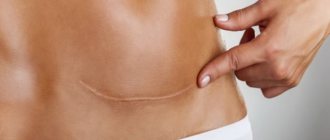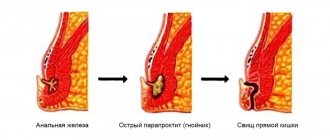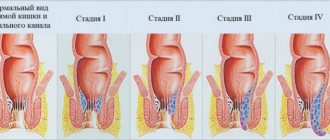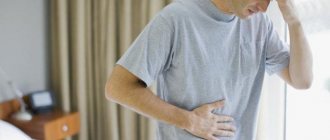Many women after childbirth face problems such as hemorrhoids. To be precise, it is not as such a consequence of childbirth. Usually this pathology occurred during pregnancy, or even earlier. And during pregnancy, especially in the last two thirds of pregnancy, the disease often intensifies.
The internal organs are compressed due to the enlargement of the uterus. This also applies to the vessels of the rectum. If a woman suffers from constipation during pregnancy, this also provokes the development of hemorrhoids. And during childbirth, hemorrhoidal cones may come out of the anus.
If a woman is diagnosed with severe hemorrhoids before giving birth, this may be an indication for a cesarean section.
Types of disease
Reasons for enlargement of hemorrhoids after CS
A caesarean section is an operation that eliminates the intense pain of childbirth without requiring as much physical exertion. But, of course, CS is not a complete panacea for hemorrhoids, and it may well appear in a woman after it, or worsen. Why does this happen? And if hemorrhoids do appear after a cesarean section, how to treat it?
CS as a way to prevent the development of hemorrhoids
Pregnancy itself can become one of the causes of hemorrhoids due to mechanical compression of the vessels of the large intestine and rectum. In addition, pregnant women often experience constipation, which is provoked by an increased amount of female hormones (progesterones) in the body during this period. They, to a certain extent, inhibit the functioning of the gastrointestinal tract, and also relax the walls of blood vessels.
And therefore, many women, especially in the last two-thirds of pregnancy, suffer from hemorrhoids. In addition, excess body weight, poor nutrition, physical inactivity or improper physical activity are also stimulators of this pathological process.
As for the CS, this operation, despite relieving the woman of the birth process and the associated overloads, has a number of negative effects on the body. First of all, it disrupts the functioning of defense mechanisms. And this can also be one of the factors contributing to the development of hemorrhoids. This is especially likely in women who have congenital disorders of the normal structure of blood vessels. After the CS, the woman must observe strict bed rest for several days. If she already suffered from hemorrhoids before the operation, then due to the forced lack of movement in the blood vessels of the intestine, blood stagnation may occur. And hemorrhoidal cones (nodes) increase in size, causing pain and discomfort to the woman.
Read also: What to do if hemorrhoids often become inflamed? Effective folk remedies
Based on the symptoms that appear, one can judge at what stage the development of this pathological process is.
- Stage 1. Lumps or nodes are located inside, on the intestinal walls, and do not fall out. At times, symptoms such as itching, bleeding, and pain are noted.
- Stage 2. After physical exertion or with strong straining during bowel movements, the nodes may fall out, but then they are set. And therefore it is not always possible to detect them.
- Stage 3. Lumps or nodes after prolapse do not move back into the anus. You can set them with your fingers, but they fall out again even with very little tension.
- Stage 4. The symptoms described above are accompanied by complications: an inflammatory process and thrombosis may occur.
How to treat postpartum hemorrhoids?
The question of how to get rid of postpartum hemorrhoids
, is relevant for many women. Treatment tactics are selected individually, taking into account the diagnostic results and the severity of symptoms. The restrictions imposed by the lactation period must be taken into account. Self-medication in this case is unacceptable, since it can cause serious harm to the health of mother and baby.
An integrated approach is justified, including:
- individual selection of a diet that excludes stool disorders;
- regular implementation of hygiene measures;
- performing special exercises;
- warm sitz baths with decoctions of plants that have an astringent effect;
- taking medications.
The latter allow you to eliminate pain, itching, swelling and eliminate tissue infection. Taking phlebotonics has a positive effect on the muscle tone of smooth muscles, strengthens the walls of blood vessels and restores blood microcirculation, due to which the nodes gradually decrease in diameter. If the patient experiences bleeding, she is prescribed anticoagulants, which stimulate the resorption of blood clots and eliminate the risk of new ones forming.
Surgical intervention is practiced in the presence of the following indications:
- Frequent exacerbations of hemorrhoids;
- Loss of nodes;
- Severe pain symptoms.
Removal is carried out using the following methods:
- Latex ligation, which involves placing a latex ligature on the hemorrhoid stem. It squeezes the blood vessels that feed it, and it dies;
- Radio wave excision, aimed at radical removal using high-frequency radio waves and coagulation of blood vessels. Suitable for external hemorrhoids;
- Photocoagulation, which uses a focused infrared beam to cauterize and initiate disruption of the blood supply to the node and its atrophy;
- Desarterization, aimed at suturing and ligating the arteries feeding hemorrhoids.
Provoking factors
Now let’s learn more about what most often actively contributes to the development of this disease in women during pregnancy and after it.
- Birth injuries.
- Excess weight. Pregnancy for many women causes them to gain, sometimes quite a considerable amount of extra pounds. And this leads to increased compression of the pelvic organs and blood vessels. If a woman suffered from hemorrhoids before pregnancy, then there is a very high probability of an exacerbation of this process, especially in the later stages. Therefore, in such cases, a woman needs to especially carefully control her weight.
- Sedentary lifestyle. This is especially true for the postpartum period. In this case, the blood vessels do not work actively enough, and stagnation occurs.
- Impaired tone of the abdominal muscles. If they are weak and lack sufficient elasticity, then this may be the cause of insufficient activity of intestinal motility. At the same time, more effort has to be made to empty the intestines, and this also increases the likelihood of developing hemorrhoids.
- Intestinal disorders. If after giving birth a woman has stitches in the perineal area, she often tries not to strain during bowel movements in order to prevent separation. However, due to irregular bowel movements, constipation may occur, which is one of the first causes of hemorrhoids.
- Varicose veins on the lower extremities. If this occurs, it can be assumed that the woman’s vessels have a special structure and do not have the necessary elasticity. Therefore, congestion in the intestinal vessels can become a factor stimulating the appearance and development of hemorrhoids.
One of the provoking factors is varicose veins
Caesarean section in patients with acute or chronic hemorrhoids
Acute hemorrhoids - occurs in a previously healthy pregnant woman. The suddenness shortly before birth significantly worsens the situation. The patient experiences severe pain and swelling of the perineum, prolapsed nodes are bluish, which indicates thrombosis. When black spots appear, the stage of necrosis is suspected. The subsequent addition of inflammation threatens the mother and fetus with sepsis. Therefore, removal of necrotic masses for emergency reasons, detoxification, and transfusion of blood substitutes are required.
In such cases, a cesarean section helps to remove the baby and prevent negative effects from the mother’s body. You cannot stimulate your own labor due to the danger of pushing. After the operation, the woman is actively treated with antibiotics and anticoagulant drugs.
For chronic hemorrhoids in a pregnant woman, surgery is prescribed for similar indications. In the fourth stage, the pathology is accompanied by infection of surrounding tissues, thrombosis and bleeding.
If the condition of hemorrhoids is determined as stage II–III without complications, then the woman is allowed to give birth naturally. Further treatment of hemorrhoids depends on the timely visit of the postpartum mother to a proctologist, the effectiveness of the prescribed medications, and the implementation of recommendations on diet and regimen.
Pregnant women should have a clear understanding of the manifestations and complications of hemorrhoids. Signs of illness do not necessarily mean the use of surgical delivery. Correct behavior and therapeutic measures help to bear and give birth to a healthy child, and in the future, purposefully resolve the issue of optimal treatment of hemorrhoids with your doctor.
Treatment of hemorrhoids
Hemorrhoids can be treated in different ways, depending on the characteristics of the body and the severity of the disease. The first of these is treatment with therapeutic agents (conservative treatment). Breastfeeding can cause difficulties, due to which a woman cannot be prescribed many medications. The second is the use of surgical intervention (surgical treatment).
Read also: Proctologists recommend what not to do if you have inflammation of hemorrhoids and what to exclude from your diet
Invasive intervention is prescribed for particularly severe forms of the disease and an advanced process, when medications and medical measures are no longer able to have an effect in the fight against this disease.
If signs of hemorrhoids appear, you should immediately consult a specialist doctor. He will select a set of necessary measures for treatment.
At the initial stage of the disease, it is effective to follow a special diet that excludes heavy foods that cause intestinal disorders. In addition, special baths, ointments, and rectal suppositories have a good effect. In each specific case, treatment is prescribed individually.
Are there any special features of cesarean section for hemorrhoids?
Caesarean section for hemorrhoids is carried out according to the standard procedure, but doctors must conduct specific examinations of the patient in advance and be prepared for the sudden development of bleeding from hemorrhoids. During preparation for surgery, a short dose of anticoagulants may be prescribed, which will improve the functioning of the blood clotting system. At the same time, a supply of donor blood is being made, because an urgent transfusion may be needed.
We recommend reading the article about acceptable pain-relieving suppositories after cesarean section. From it you will learn about popular pain-relieving suppositories after cesarean section and their side effects during breastfeeding. And here is more information about the third caesarean section.
Hemorrhoids after cesarean section are not a rare complication. If the pathology is diagnosed in time, the doctor will select medications, create a diet and give recommendations to the woman regarding treatment. Competently following all the specialist’s prescriptions is a guarantee of a quick recovery, the absence of classic complications and the need for another surgical intervention.
Prevention of hemorrhoids
If a woman had similar problems before pregnancy and childbirth, she should definitely follow preventive measures. We must not forget about hygiene. After bowel movements, you must thoroughly wash the anal area. Then blot it dry with a napkin or clean soft cloth so as not to irritate the sore spots. When defecating, do not use excessive force.
Compliance with nutritional rules is good prevention
The diet should not contain hot, spicy foods, large amounts of animal fats, you need to limit the amount of baked goods, sweets, and eat more fresh vegetables and fruits containing fiber, as well as complexes of vitamins and minerals. It is also very important to remember that movement is necessary so that the blood does not stagnate in the vessels.
Causes of hemorrhoids after cesarean section, what provokes its development and treatment methods
Many women after childbirth face problems such as hemorrhoids.
To be precise, it is not as such a consequence of childbirth. Usually this pathology occurred during pregnancy, or even earlier. And during pregnancy, especially in the last two thirds of pregnancy, the disease often intensifies. The internal organs are compressed due to the enlargement of the uterus. This also applies to the vessels of the rectum. If a woman suffers from constipation during pregnancy, this also provokes the development of hemorrhoids. And during childbirth, hemorrhoidal cones may come out of the anus.
If a woman is diagnosed with severe hemorrhoids before giving birth, this may be an indication for a cesarean section.
Types of disease
conclusions
What should a woman who has given birth do, given that many people develop hemorrhoids during pregnancy? These tips are universal, no matter what kind of birth you have.
I understand that I don’t seem to care about myself while the child is small. But you can believe me that when your child grows up, the load on you will also increase. And the hemorrhoids will become larger. Then it will be even more difficult to cope with the disease. After all, the well-known expression “Healthy mother - healthy baby” did not arise out of nowhere.
And if the proctologist said that hemorrhoids need (can be!) removed with a laser, and you are breastfeeding, then this is not a problem. You only miss one feeding. There is no need to cancel it completely, but you shouldn’t wait for it to end either.
Having experience of many hundreds of operations, including on nursing mothers, I can authoritatively tell you: after laser coagulation of hemorrhoids there is no pain, you do not need to take any painkillers. The only thing you need is drugs that soften the stool - phytomucil norm or colonprotect. They can be taken both during breastfeeding and during pregnancy as a laxative.
Eliminate your health problems in a timely manner; and most importantly - Be healthy!
Sincerely, Vitaly Arkadyevich Ilyin, proctologist, candidate of medical sciences
Source
Inflammation of hemorrhoids during pregnancy and after childbirth
But what should a young mother do if hemorrhoids appeared during pregnancy and became inflamed after childbirth?
If you, my dear readers, have read the article “Pregnancy and hemorrhoids: new approaches to treatment,” then you already know why hemorrhoids occur and progress during pregnancy. For those who did not have time to read the article or forgot, I will explain. The pregnancy hormone progesterone relaxes the uterus so that pregnancy can develop. Simultaneously with the uterus, progesterone relaxes the veins, intestines, and ligaments. Under the influence of this hormone and the growing uterus, hemorrhoidal veins expand and hemorrhoids appear.
In this case, external hemorrhoids most often form and, less often, internal hemorrhoids.
Causes and symptoms
So, we agreed: hemorrhoids appear during pregnancy. Alas, it remains with you in later life if it is not removed.
Why is that? External hemorrhoids behave like varicose veins in the legs. Very often these diseases occur together during pregnancy. Or progress if they were there before. Therefore, just as varicose veins will not go away after childbirth, so hemorrhoids will also remain with you. And just as varicose veins will progress and cause problems, so hemorrhoids will increase and bother you.
Have you noticed an extra fold in your anus after giving birth? This is an external hemorrhoid with a 90% probability.
Is the fold gradually enlarging or new ones appearing? These hemorrhoids are growing.
The fold hasn't changed yet? This does not mean that hemorrhoids have disappeared or are not progressing: while the nodes are not large, their bulk is located deeper, in the anal canal. Can you check for hemorrhoids yourself? Yes, immediately after defecation, preferably without getting up from the toilet, wash your butt and touch it with your fingers. You can strain quite a bit. Soft tissue is identified under the fingers, and when you press on it, it decreases. This is the external hemorrhoid.
In such a situation, there is nothing I can do to please you. Go to a proctologist. The smaller the node, the easier it is to remove it with a laser.










